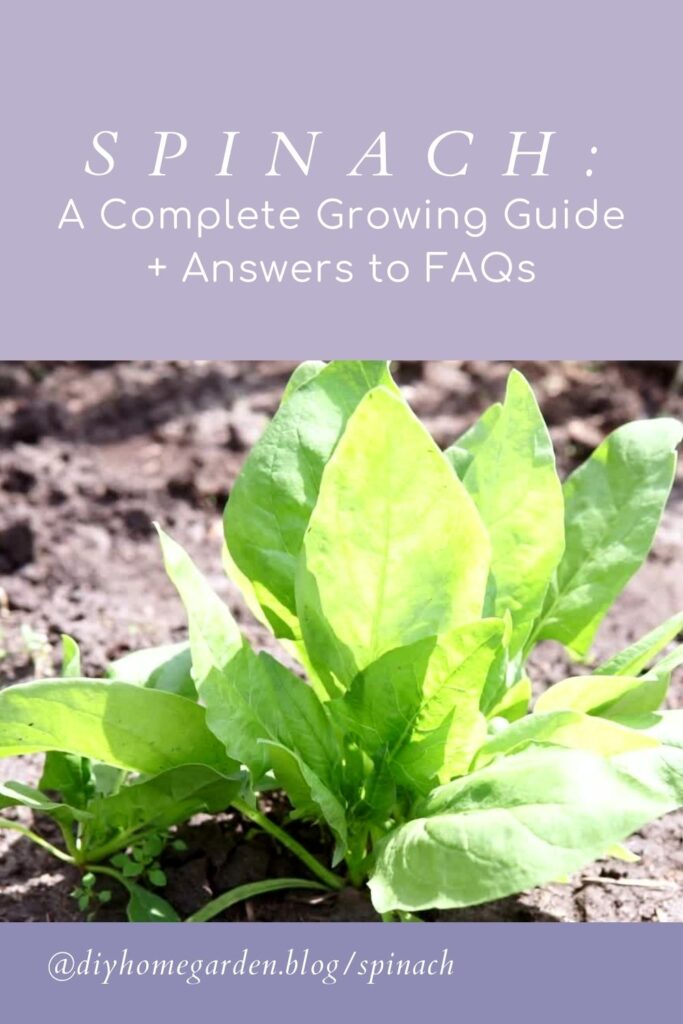Spinach (Spinacia oleracea), a green Persia-native vegetable, is an excellent source of calcium, iron, and vitamins A, C, B, and K.
It belongs to the amaranth family alongside beets, quinoa, and Swiss chard.
Like lettuce, spinach craves excellent growing conditions, although more versatile in both nutrition and ability to fit into various disparate dietary approaches—vegan, omnivores, and ketogenic.
Eaten cooked or raw, spinach may help reduce oxidative stress, prevent cancer, benefits eye health, and keep blood pressure levels in check.
Frequently Asked Questions About Spinach
This article goes over everything you need to know to grow and care for this superfood—by answering some of the commonly asked questions.
What is the best way to grow spinach?
- Spinach grows best in moist, nitrogen-rich, well-draining soil with a pH between 6.5 and 7.5.
- It’s best planted in the cool weather of fall, spring, or winter (for areas with mild winters).
- A week to planting, work in compost or aged manure into your garden soil, loosen it approximately a foot to accommodate the plant’s extensive taproot.
- Directly sow the seeds into the soil once outdoor temperatures hit at least 40° so your crop benefits from the vital six weeks of cool weather it desperately craves from seeding to harvest.
- Use some plastic to cover the soil to speed its warming, which will, in turn, boost the germination process.
- Be sure to space the seeds three inches apart in rows to allow maximum growth room.
- Once the seedlings sprout to approximately two inches (five cm), thin them eight to ten cm (three to four inches) apart.
- Roots are shallow and very susceptible to damage at this stage, so simply mulch and water regularly to keep the soil moist.
- Spinach is quite a heavy feeder. Therefore, feed as needed throughout the growing season with a nitrogen-high fertilizer, following the manufacturer’s instructions.
- Soy meal and fish emulsion are great organic choices for feeding this plant.
Can you start spinach indoors?
This might be the question running through your mind at this point.
Yes, you can start the seeds indoors; however, to save the seedlings’ delicate roots from the sluggish recovery process from transplant shock, you may want to simply direct sow.
How long does spinach take to grow?
Spinach takes only six weeks to mature from planting to harvest.
How do you prepare spinach for soil?
You may be thinking of starting your spinach plants in a DIY nursery…In that case,
- Begin by identifying the preferred nursery location and clear it of any weeds. Dig the soil, loosening any lumps.
- A week before planting, mix a seven cm compost layer into the soil, then water thoroughly. The best rule of thumb is to use a wheelbarrow of manure for every three square meters.
- Soak the seeds for 24 hours in cold water before planting.
- In a line, sow the seeds two cm (0.8 inches) deep in rows six inches (fifteen cm) apart; then cover lightly with soil.
- Add dry grass on top as mulch—to help with moisture retention. Water the bed.
- Seeds will germinate within five to seven days. Remove the grass and erect a-1m high grass shade over the nursery bed, ensuring some sunlight can penetrate through.
- Keep the soil consistently moist (not overly wet), so the seedlings don’t die. Transplant once they develop three to four leaves.
How far apart should I plant spinach?
Space your spinach transplants four to six inches apart.
Does spinach need sun or shade?
Though a complete sun lover, spinach appreciates light afternoon shade, especially in hot climates.
What month do you plant spinach?
As mentioned before, spinach is a cool-weather crop. Therefore, sow the seeds as early as six weeks before your area’s last frost or whenever you can work the soil.
For areas with long cool springs, consider successive plantings every ten to twenty-one days until mid-May (in the Northern Hemisphere.)
Can I grow spinach indoors?
Or simply, ‘Can I grow spinach in my kitchen?’
Yes. Spinach, like most vegetables, will grow incredibly well indoors. All you need is seeds, well-draining potting mix/soil, water, and a growing pot at least five to twelve inches deep.
- Not much care is required except for regular fertilizing and watering.
- Four to six hours of sunlight a day is sufficient.
- Thin the leaves as needed and look for any signs of disease or pests.
How often should I water my spinach plants?
- Water your spinach regularly, especially in warm weather, to keep the plants from bolting. 1-1 ½ inches of water a week should suffice.
- Consider spreading your watering schedule throughout the week instead of just a weekly deep watering.
- Apply a light mulch of straw or grass clippings around the plants—to help with moisture retention and keep the weeds at bay.
Will spinach grow back after cutting?
Spinach, like most vegetables, will grow back when harvested the right way—in the cut-and-come-again method.
Once you harvest the crop, simply offer it water to boost the production of more leaves.
Does spinach multiply?
- Provided the weather is conducive, and you don’t interfere with the crop’s tender growing point during the initial harvesting, it will faithfully multiply.
- To properly harvest your spinach, use a sharp knife or garden scissors. Trim off individual leaves, starting with the outer leaves, and leaving the young inner ones to grow for a later harvest.
- If you decide to harvest the entire plant at once, then cut it by the base—about 3cm above the crown—so you can harvest again and again when the plant puts forth a new set of leaves.
- Regardless of your preference, avoid waiting too long—because the more extensive the leaves get, the more bitter they become!
Do spinach plants come back every year?
No, this plant is an annual, growing only for a single season.
What grows well with spinach?
Spinach will do perfectly fine alongside several plants, including the brassicas, tansy, dill, garlic, peas, strawberries, tomatoes, and radishes but not fennel. Fennel, among other plants, naturally releases compounds that eliminate any competing plants around it.
What is the fastest-growing vegetable?
- Besides spinach, other fast-growing vegetables to try this season include arugula, bok choy, broccoli rabe, cress, radishes, kale, mustard greens, and turnips.
- All are considered cool-season crops—largely dependent on cool weather to develop their best flavor. These also will benefit from some light shade to avert early bolting.
Common Challenges When Growing Spinach
Though an easy vegetable with a fast-maturity rate, it may be a little tricky to care for spinach, especially if you run into problems that you have no idea how to fix.
To help you out, here are a few of the most common issues you may encounter and their solutions:
Spinach seeds aren’t germinating
- If your seeds failed to germinate, then it was too warm, too cold (or wet), or the seeds were too old and therefore not viable.
- Always use less-than-a-year-old seeds and plant in cool, well-draining soil.
Seedlings aren’t growing
- It could be due to too much shade, dry/wet soil, or hot weather.
- Ensure the soil is evenly moist and fertilized to see if it will trigger new growth.
- Otherwise, consider adjusting your planting schedule next season.
Seedlings keep bolting
- Hot temperatures are the primary cause of bolting, but transplanting is to blame in some cases.
- Direct-sow your seeds either in early spring or fall for a healthy winter crop.

The Takeaway: Spinach Is a Wonderful Addition to Your Garden, But It Requires Some Know-How to Start
Spinach is an excellent choice to add to any garden for its nutritional value and abundant yield. However, it takes careful attention to watering, light conditions, and heat. Once you grow this wonderful green vegetable, you’ll wonder how you ever did without it.


